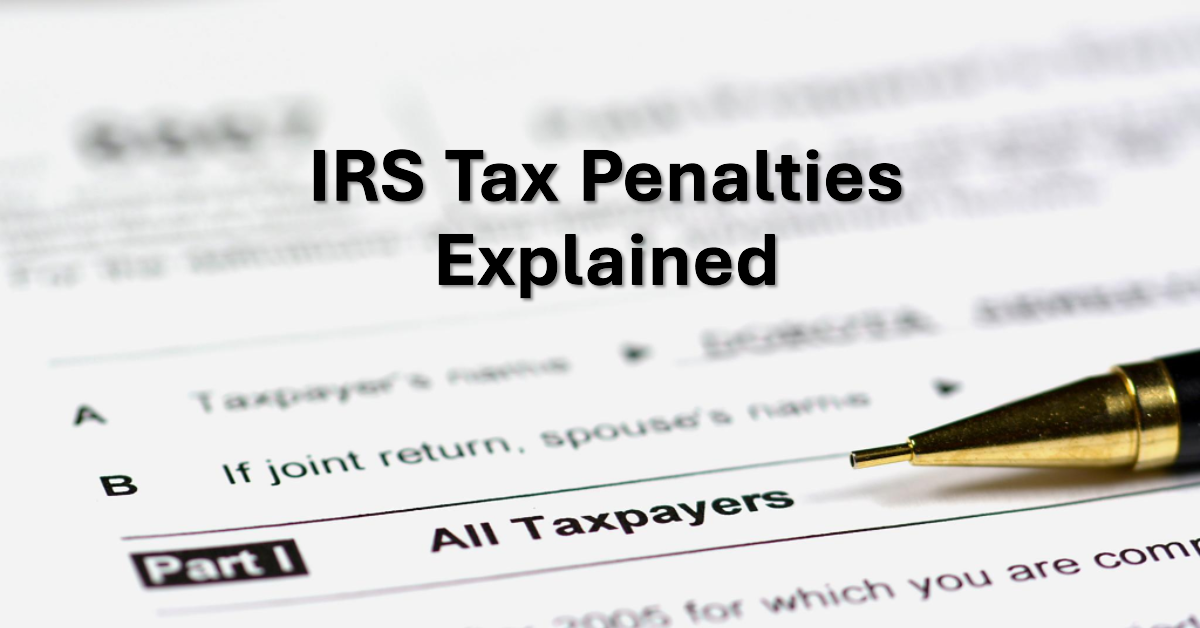Are you a W2 employee or 1099? Are you receiving a fixed pension? With any of these, tax penalties can be severe if you incorrectly estimate your taxes owed.
It is common for a W2 employee to have their taxes automatically deducted based on their individual income. What if you’re married? Have a second job? Run a business on the side? Any one of these factors can cause a W2 employee to owe much more than what is being automatically deducted. If you are a 1099 employee, you must make your estimated tax payments on your own. Retirees receiving a pension are generally withholding too little or too much. Estimating your taxes can be easy when you have the correct tools. If you’re a federal employee exploring ways to improve your approach, consider our tax strategy for federal employees.
What is the Penalty for Underpayment of Taxes?
The Failure to Pay Penalty is 0.5% for each month you have underpaid. There is also a Failure to File Penalty that is 5% of the unpaid taxes for each month that a tax return is late. The penalty will not exceed 25% of your unpaid taxes.
If both a Failure to Pay and Failure to File Penalty are applied in the same month, the Failure to File Penalty is reduced by the amount of the Failure to Pay Penalty for that month, for a combined penalty of 5% for each month that you return was late.
Generally, most taxpayers will avoid this penalty through the Safe Harbor rule. There are three components to the Safe Harbor rule:
- Owe less than $1,000 in tax after subtracting withholdings and credits OR
- Paid at least 90% of the tax for the current year OR 100% of the tax shown on the return for the prior year, whichever is smaller.
How to Estimate Your Tax Withholdings
On a regular basis, we use an effective tax rate calculator. You can find the calculator at the SmartAsset effective tax rate calculator. The US tax code follows a progressive tax system so even if you fall in one tax bracket, your effective tax rate is usually much lower.
Example (living in Virginia):
- Spouse 1 = $175,000
- Spouse 2 = $45,000
- Combined Income = $220,000
- Federal Tax Bracket = 24%
- State Tax Bracket = 5.75
In this example, you may be in the 24% federal tax bracket and 5.75% state bracket, however your effective tax rate would be much lower at 15.57% federal and 5.35% state. Using an effective tax rate calculator will help you better determine your taxes owed.
Estimated Tax Payments Are Due as Follows (for 1099 earners):
- January 1 to March 31 – April 15
- April 1 to May 31 – June 15
- June 1 to August 31 – September 15
- September 1 to December 31 – January 15 of the following year
Where to Send Estimated Taxes:
You may send estimated tax payments with Form 1040-ES by mail or you can pay online at the IRS payment portal.
Reach Out to Us!
If you have additional federal benefit questions, contact our team of CERTIFIED FINANCIAL PLANNER™ (CFP®), Chartered Federal Employee Benefits Consultants (ChFEBC℠), and Accredited Investment Fiduciary (AIF) professionals. At PlanWell, we focus on financial planning for federal employees. Learn more about our process designed for the career federal employee.
Preparing for a federal retirement? Check out our scheduled federal retirement workshops. Sign up for our no-cost federal retirement webinars. Make sure to plan ahead and reserve your seat for our FERS webinar, held every three weeks. Want to have PlanWell host a federal retirement seminar for your agency? Reach out, and we’ll collaborate with HR to arrange an on-site FERS seminar.
Want to fast-track your federal retirement plan? Skip the FERS webinar and start a one-on-one conversation with a ChFEBC today. You can schedule a one-on-one meeting.
Sources:
https://www.irs.gov/payments/failure-to-file-penalty
https://smartasset.com/taxes/virginia-tax-calculator#x3IBu7pXoy
Form 1040-ES: https://www.irs.gov/pub/irs-pdf/f1040es.pdf
Mail to addresses by state: https://www.irs.gov/filing/where-to-file-addresses-for-taxpayers-and-tax-professionals-filing-form-1040-es










